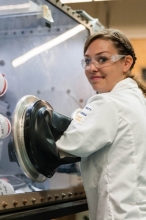
University:
Major:
Mentor(s):
Faculty Sponsor(s):
Faculty Sponsor's Department:
Project Title:
Project Description:
To create more efficient power generation systems, the operating temperature of the SiC/SiC components needs to be increased up to 1500 °C. Current fabrication methods have proven ineffective in making SiC/SiC composites operable at temperatures above 1350 °C. Shrinkage cracks form during polymer impregnation and pyrolysis (PIP) processing of SiC/SiC composites, reducing their oxidation resistance and mechanical integrity. This work aims to minimize the number of shrinkage cracks by filling the area around the SiC fibers with SiC particles before PIP processing. We studied the effect of different SiC particle sizes on the packing density of particle beds, the precursor infiltration rate and the final microstructure of the composite. To do this, we made particle beds in glass tubes with different particle sizes and infiltrated these with SMP-10 precursor which was then cured at 120 °C. The precursor was pyrolyzed at 850 °C to form a SiC matrix. The infiltration rate follows Darcy’s Law for flow of fluids through porous media, with beds of larger particle sizes infiltrating faster. SEM imaging of the PIP processed fiber beds showed that the larger gaps and pores in the particle beds and were not filled, most likely due to their lower capillary pressure. The current results give rise to the conclusion that SiC/SiC composites can be improved by combining PIP process with a previous SiC particle slurry infiltration step. This will be verified in future works by infiltrating the fiber beds with a particle slurry prior to infiltrating the beds with SMP-10 precursor.
